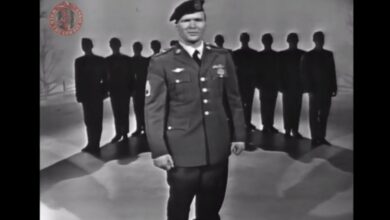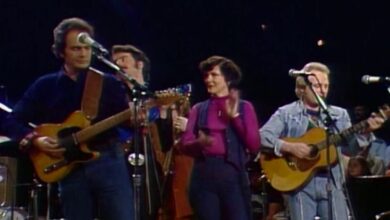The performance evokes pride and gratitude, honoring American veterans among listeners.
Sgt. Barry Sadler’s “Ballad of the Green Berets,” released in 1966, endures as a compelling symbol of military honor and sacrifice, particularly associated with the elite forces of the U.S. Army during the tumultuous Vietnam War era. The song emerged amidst significant social upheaval, reflecting a growing division in public opinion about the war and creating a stark contrast between military pride and burgeoning anti-war sentiments. With his own experiences as a Green Beret, Sadler offered a unique vantage point that allowed him to share his personal journey and emotions through the lyrics of this iconic ballad, resonating deeply with both soldiers and civilians.
Born in Carlsbad, New Mexico, Barry Sadler encountered numerous challenges in his formative years. His childhood was marked by the emotional fallout from his parents’ divorce and the loss of his father at a young age. These early adversities instilled in him resilience and a desire for camaraderie, traits that would later emerge during his military service. In 1958, Sadler enlisted in the U.S. Air Force before transferring to the Army, where he discovered his true calling and earned the distinguished title of Green Beret, defining much of his adult identity.
During his service in Vietnam, Sadler faced the harsh realities of combat, and it was one of these intense experiences that left him severely injured by a booby trap. This injury led to a long period of recovery and introspection, during which he wrote “The Ballad of the Green Berets.” The song not only pays homage to the bravery and valor of the Green Berets but also reflects the bonds forged in the heat of battle. It encapsulates the essence of military life—loyalty, sacrifice, and honor—through the eyes of someone who had experienced these values firsthand.
The debut of “The Ballad of the Green Berets” coincided with a time of critical societal upheaval surrounding the Vietnam War, as many Americans were re-evaluating their views on the military and the conflict itself. As opposition to the war mounted, Sadler’s ballad emerged as a proud affirmation of the soldier’s mission. Its stirring melody and heartfelt lyrics became a rallying cry for those who supported the troops, effectively capturing the spirit of military service. The song swiftly climbed to the top of the Billboard Hot 100, where it remained for five consecutive weeks. Its success not only marked a significant milestone in popular music but also revealed the complex relationship between Americans and their military.
Despite the notable success of his ballad, Sadler struggled to replicate that triumph in his later endeavors. Following his brief career as a singer, he shifted his focus to writing and acting, producing a variety of novels and exploring other artistic avenues. Among his literary work was the pulp fiction series “Casca,” which depicted the life of a Roman soldier doomed to roam through time. Nevertheless, the overwhelming recognition of “The Ballad of the Green Berets” often overshadowed his later contributions, consistently tying his legacy to that singular, impactful song.
In the years following his military service, Sadler faced numerous personal challenges. His later life was complicated by legal issues and a serious injury he sustained during a shooting in Guatemala, which affected both his health and personal circumstances. This contrasted sharply with the earlier glory associated with his military achievements and musical success. Even through these trials, however, Sadler retained his connection to the themes of duty and honor that had characterized his previous life, continually contemplating the sacrifices made by service members.
Barry Sadler’s life came to an unfortunate conclusion in 1989, yet he left behind a meaningful legacy that continues to resonate within American culture. “The Ballad of the Green Berets” is frequently performed at military ceremonies and memorial services, serving as a heartfelt tribute to those who have served and sacrificed for their nation. The song not only embodies the valor of the Green Berets but also resonates with all service members, honoring their unwavering commitment amid the challenges of war.
The lasting relevance of Sadler’s anthem underscores the intricate relationship between military service and public sentiment. As generations reflect on the legacy of armed conflicts, “The Ballad of the Green Berets” continues to convey themes of pride and sacrifice that transcend political divides. For many, it serves as a reminder of the personal toll of war, the courage inherent in military life, and the importance of honoring those who serve, irrespective of the controversies that may surround their missions.
Over the years, various artists have covered and adapted the song, showcasing its timeless allure. Each reinterpretation introduces the ballad’s powerful message to new audiences, ensuring that Sadler’s legacy continues to evoke respect and admiration for military service. The influence of “The Ballad of the Green Berets” is evident across multiple platforms, from film and television to public commemorations, creating a bridge between history and contemporary discussions surrounding military honor and sacrifice.
Ultimately, Barry Sadler’s “Ballad of the Green Berets” serves not only as a song but as a cultural landmark, encapsulating the complexities of military identity and experience. It fosters a sense of connection between the military and the broader American populace, promoting understanding and respect for those who serve. The themes of loyalty, sacrifice, and courage embedded within the song continue to resonate, providing a poignant reminder of the sacrifices made by countless individuals in uniform throughout history, as well as the enduring spirit of service that resides in those who answer the call to serve.





